In football, possession is not everything. While we may associate it with domination, it doesn’t always translate into success on the pitch. Sometimes, teams will look to create through different means and losing possession, while it may seem counterproductive, can indeed yield advantages.
This tactical theory will aim to identify teams who thrive in chaotic scenarios where a lost ball is suddenly turned into a dangerous transition and use tactical analysis to dissect the tactics that lead to such occasions.
Initial data check
Fishing for teams who seemingly lose possession on purpose would be like looking for a needle in a haystack. So before we delve into the analysis, we first have to identify the teams who fit the narrative. Theoretically, teams that lose possession on purpose would have to naturally have low possession percentages but high pressing figures.
They are the teams who prefer a good counter-press over an accurate ball, teams with players who tally high assist values but record few accurate passes overall and teams who tend to go long often and then turn defensive actions into goal or shot-creating actions. These are our rough criteria for finding such teams and a short data analysis can hopefully point us in the right direction.
A good place to start is to look at possession dominance and the reliance on a high press. Just a note that I’ve combined pressures in the middle and the final third per 90 to get the high press metric you can see in the graph below.
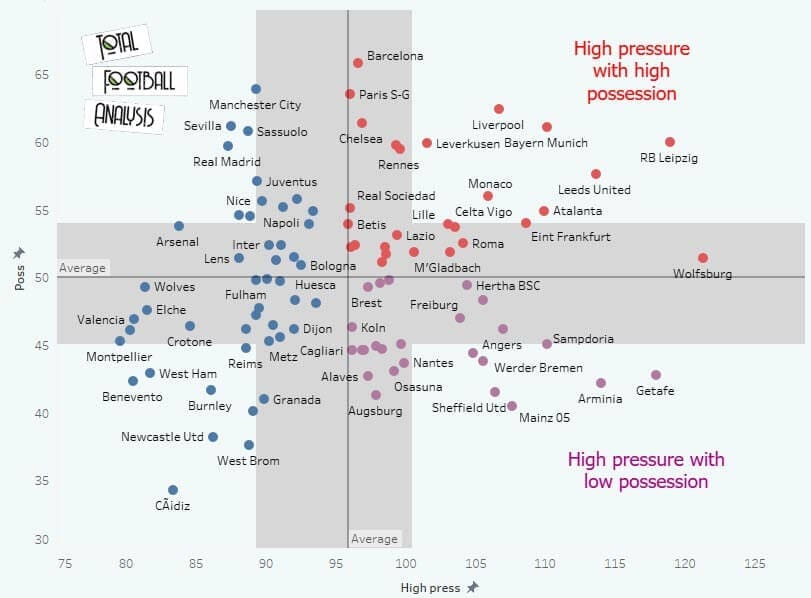
Likewise, I’ve highlighted two groups of teams, which will be the case throughout this data analysis part – the possession-heavy and non-possession-heavy teams. The reason behind it is that while we may associate low possession values with teams who willingly yield the ball, it is also possible that possession-dominant teams give it away on purpose for the same end goal.
Teams like Liverpool, Bayern Munich, Bayer Leverkusen and RB Leipzig are such teams who generally dominate possession and are very aggressive once they lose it. On the other hand, teams like Arminia, Getafe, Mainz 05 and Werder Bremen are teams who don’t see much of the ball but will still press the opposition into oblivion often. This is a great starting point because it gives us teams who show enough aggression to fit the narrative while also separating them into two clear clusters.
However, unless that aggression translates into advantages, it’s not useful. For that reason, we’ll now look at teams who create a lot of shot and goal-scoring opportunities through their defensive actions. Equally, a successful counter-press can translate into a quick and deadly sequence, meaning it often includes low touches in the danger area (final third + penalty area).
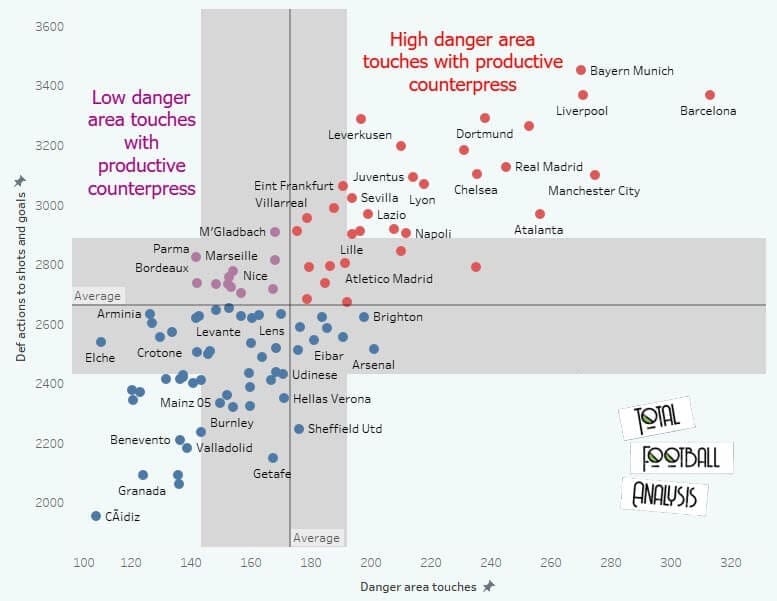
Once again, we’ve separated the teams into two groups since high-possession teams or in this case, teams with high danger area touches, can still generate a lot through their effective counter-pressing. Again, Bayern Munich, Liverpool, Barcelona, Leverkusen and the likes are amongst such teams.
On the other side, Köln and Brest, despite not being visible on the graph, are in that cluster along with Parma, Marseille and Nice. These are the teams who need only a few touches to translate defensive actions into chances and fit our criteria.
But to round up the data analysis part, we need a graph that will show us teams from both ends of the spectrum in one. For that, we’ve used defensive actions that lead to shot and goal-scoring opportunities and attempted long balls.
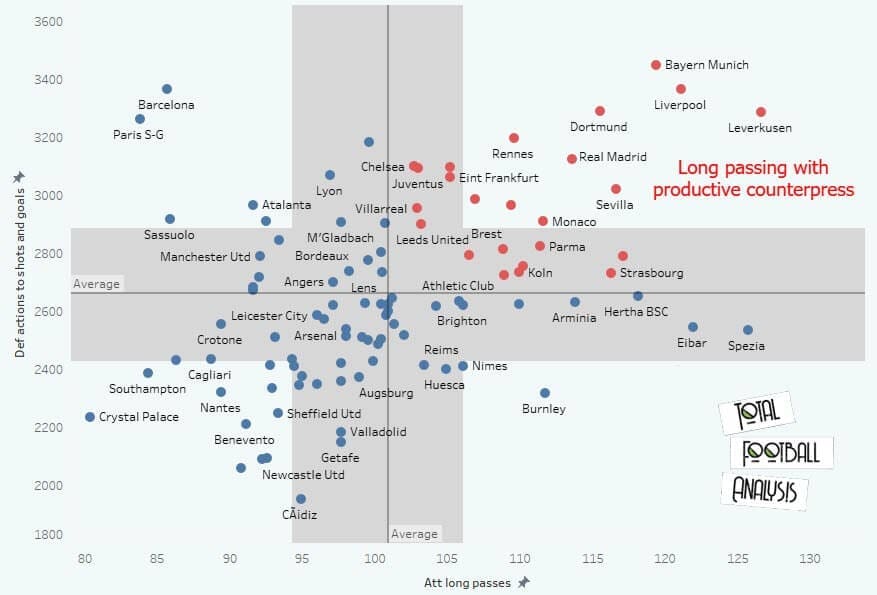
It is unlikely that teams use short passes to lose possession on purpose but rather go long into areas that will yield them better counter-pressing situations. So teams who rank high in both of these metrics are generally teams who will play risky passes that result in a loss of possession and subsequent immediate defensive action which ideally translates into a great offensive transition with an end product. In other words, teams that have featured in the first two graphs, on either end of the spectrum, and now feature together in the third are our likely contenders.
To conclude, both possession-dominant and non-possession-dominant teams can use these tactics but they sometimes apply slightly different concepts to achieve their goal. It is also not so much about losing possession on purpose but rather guiding the ball into specific areas where counter-pressing is easier and attempting risky passes with counter-pressing as a safety net.
Both scenarios are intending to progress play into dangerous areas without having a free target occupying it but rather using the opposition player instead. Deliberately yielding possession and then counter-pressing while the other team is disorganised is a complex and often risky approach but also effective when executed properly.
Let’s see how exactly.
High-risk passing into effective counter-pressing
As was previously alluded to earlier in the tactical analysis, often teams won’t lose the ball on purpose but will attempt risky passes with counter-pressing as their safety net. Equally, even if they know the pass is unlikely to reach the target, they will have a good counter-pressing structure around it so that the ball can immediately be won back in targeted danger areas.
Teams such as Hoffenheim and Leverkusen are ball-dominant teams who use these tactics a lot while on the opposite spectrum, Köln and Arminia do the same with low possession values. The principles are generally the same as all four of them send balls towards a high-priority area despite low chances of success with a counter-pressing structure in place to immediately recover possession.
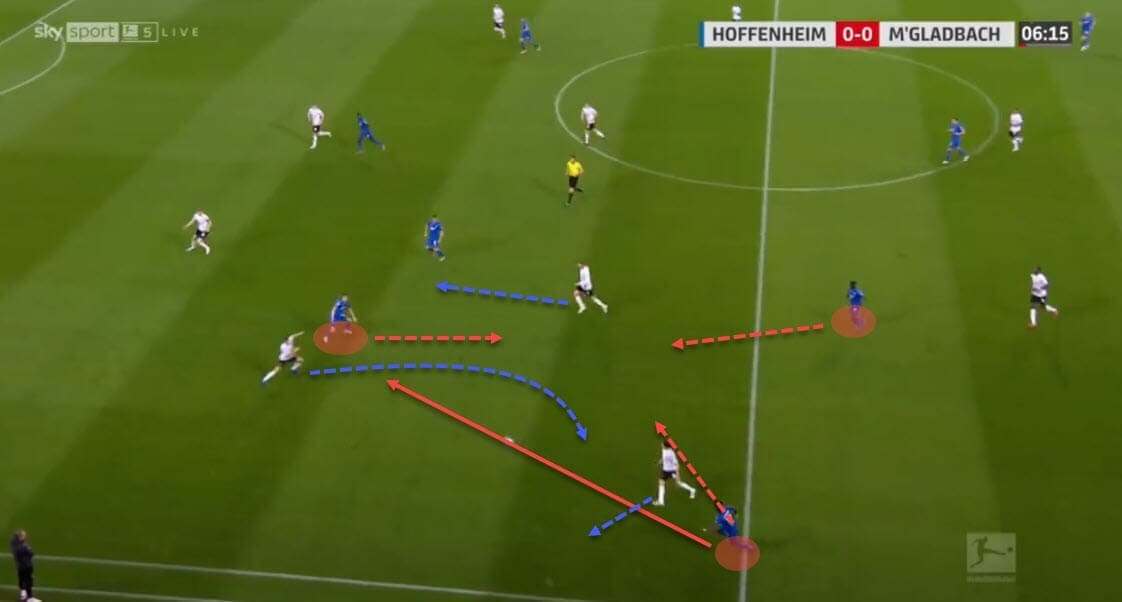
In the example above, Hoffenheim are trying to access the half-space but Borussia Mönchengladbach have it covered pretty well, which results in a lost ball. However, notice how the opposition player is then forced wide and soon collapsed upon in a 3v2 situation as the counter-pressing structure was ready in case of a turnover. More often than not, such situations then translate into an offensive transition quickly and Hoffenheim are among teams who turn those into clear-cut chances on goal.
Equally, Bayer Leverkusen do very similar things in possession. When there is no way to systematically breach the defensive block, they will use the opposition player as a reference point for where the play needs to be transferred to.
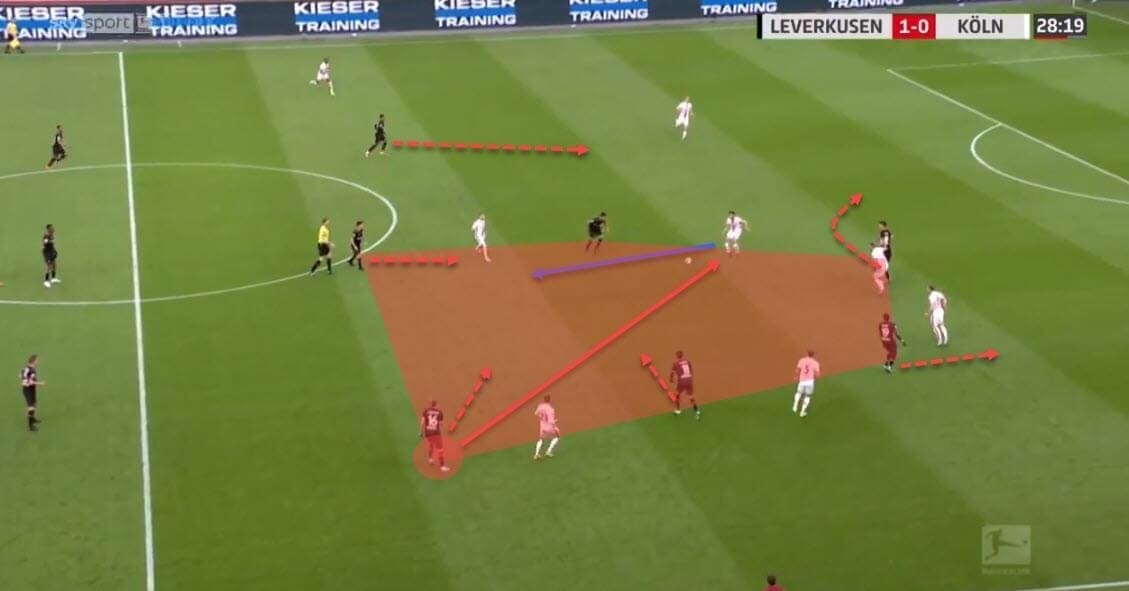
Here, a misplaced pass is quickly turned into a great counter-pressing sequence with clear outlets to immediately progress the ball into the danger area. Three players collapse on the ball while the other three are staying higher and act as targets once possession has successfully been regained.
At first, all priority targets seemed well covered but as the ball is handed to the opposition, the defensive structure scrambles in an attempt to transition into an attacking play. This means that once the counter-pressing has been successful, it’s easier to play through the once compact block.
Köln use similar principles where low accuracy still translates into chances. In the image below, they attempt a through ball on the left flank which is intercepted by the opposition defender. However, with the ball being very difficult to control, chances are it will go to the nearest teammate or it will just be blindly cleared.
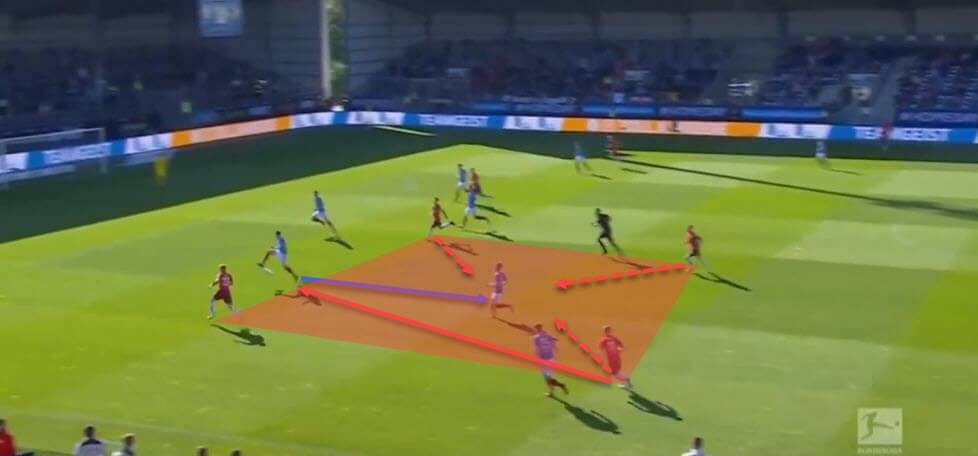
In this case, it falls to the nearest teammate but he is easily collapsed upon and Köln successfully draw out the opposition and then attack a disorganised block following a ‘bad pass’.
Finally, we have Arminia who use lost possession to counter a counter-attack. At first, we see them attempt a risky pass through the centre which is easily intercepted and the opposition start a quick transition, pushing forward with pace and more importantly, with numbers in their attack.
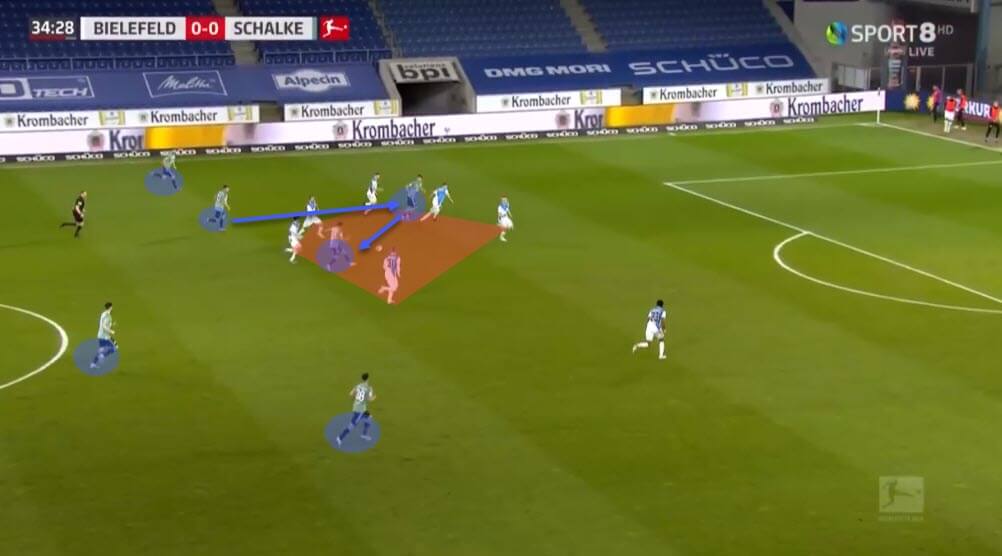
However, the only way to advance is through a tight central corridor where Arminia have a counter-pressing structure in place. The screenshot shows a clear path towards the left flank but that channel was closed at the moment when the first player received possession so the only way forward was through the centre.
Soon, the collapse regains possession for Arminia and suddenly, as their counter is on, six Schalke players are eliminated with a couple of quick touches. While it may not necessarily be deliberate loss of possession, it is at the very least a calculated one.
If we attempt this pass, what are the chances we can still regain the ball and advance the attack? Equally, how likely are we to successfully counter-press in case the attempt goes awry? If both of those terms are met with a positive response, losing possession suddenly becomes a far less risky outcome.
Counter-pressing the second ball
We’ve established that teams often use long balls to set up their counter-pressing sequences. This is similar to the previous section that dealt with risky passes into a good defensive action, only this time, the aim is to force the opposition to receive passes that are difficult to control and then win the second ball rather than the initial aerial battle.
Teams such as Liverpool or Bayern Munich are particularly good at this as their counter-pressing structure is always in place to collapse on the second ball and quickly progress play forward. Here are two examples of how the Premier League titans do it. Against Wolverhampton Wanderers in the following example, the ball is cleared towards the final third but while Mohamed Salah can be a target, he is not a realistic one at all.
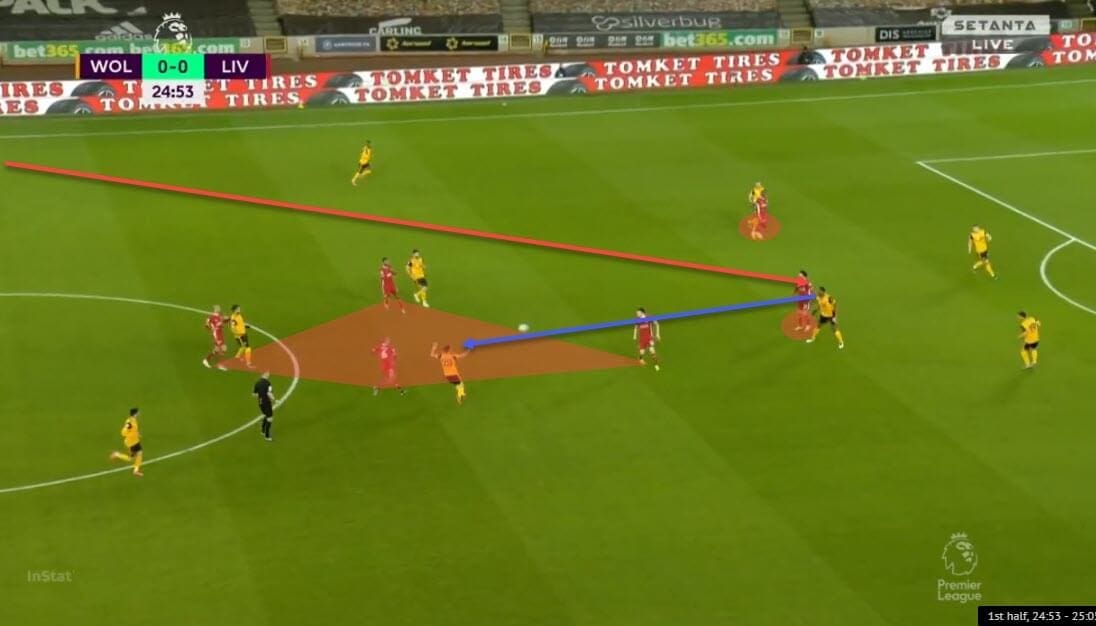
However, the intention was never for the Egyptian to win the aerial duel but rather for Wolves to clear it towards the targeted area highlighted in the image. Notice how Liverpool have a 4v3 overload secured and a collapse ready to instantly win the ball and quickly transition forward.
When teams struggle to play through the block and playing over it is also not an option, preparing to win the second ball in an advanced area is a good way to approach such situations. Below, again, Trent Alexander-Arnold clears the ball towards Salah and while retaining the ball immediately would be great, it is not expected.
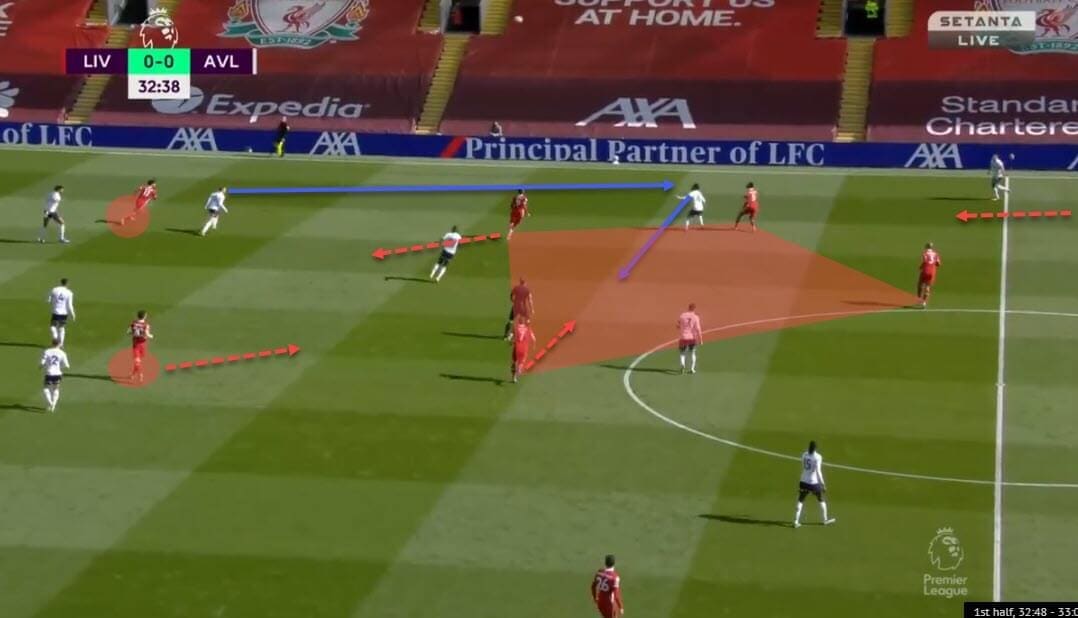
Instead, they predict where the fight for the second and the third ball will be held and overload that area instead. There are a couple of common features of this aspect we have to take note of. Firstly, notice that there are always clear outlets should the second/third ball be won in the desired area.
Secondly, superiority of some kind has to be achieved in said area, either quantitative or qualitative. And finally, although it’s difficult to see it in these images, cover is always provided behind the counter-pressing unit.
Let’s take a look at Bayern’s setup and try to note any similarities. The setup, as you can see, is almost identical. A long ball is played into an unlikely target but the Bavarians predict where Paris Saint-Germain will clear the attempt.
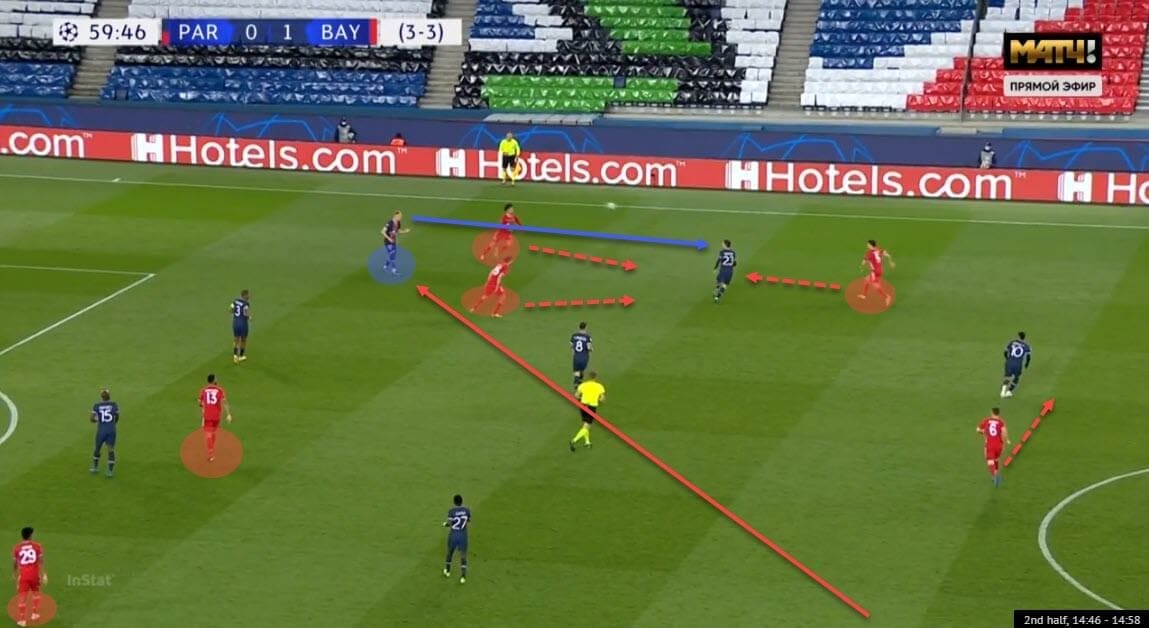
Then, they counter-press the second ball, regaining possession. While this may not necessarily yield an immediate goal-scoring opportunity, it still advances play if no other route is accessible. Again, Bayern have achieved an overload, have clear outlets that have the backline pinned and also provide cover for the counter-pressing unit, checking all three boxes.
Here, again, against Berlin. The ball is sent long and the opposition win the aerial duel but clear it towards an onrushing Bayern unit. They have achieved superiority in the area where the ball will land, have clear outlets already in position for a sprint behind the backline and support arriving just off-screen.
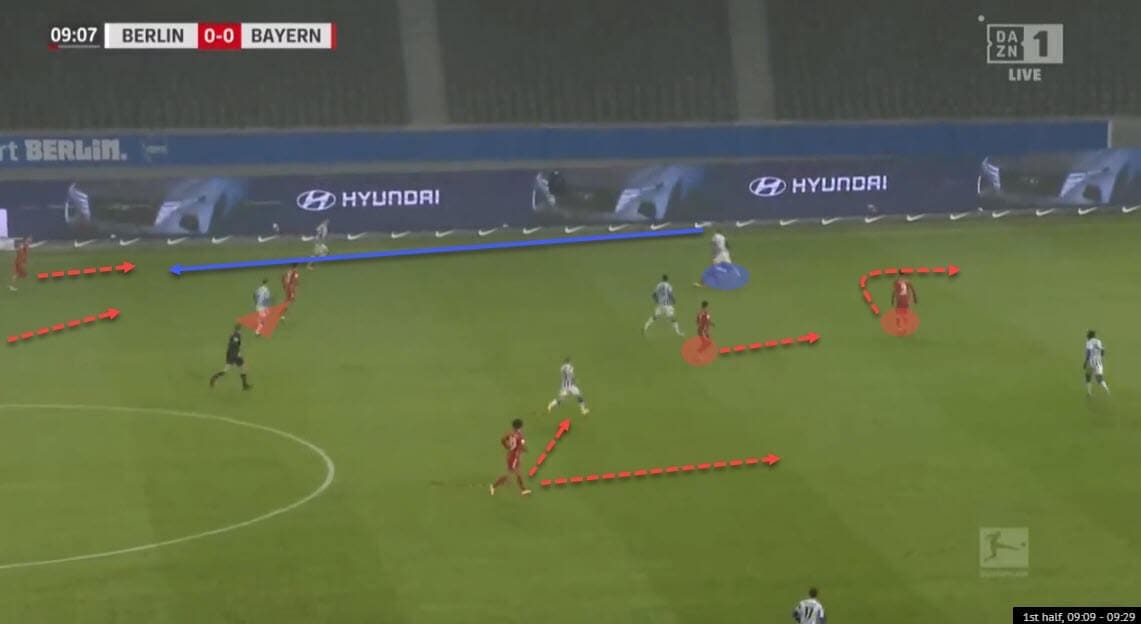
Finally, we’ll take a look at Arminia, a team who don’t enjoy large spells of possession domination as Bayern or Liverpool might, but still utilise a similar approach. In the following example, the setup is almost identical to the previous couple of situations.
Arminia have cleared the ball towards a targeted area without fully expecting the pass to be successful nor the ensuing aerial battle to be won. What they do have, however, is a clear counter-pressing structure in place should they really yield possession.
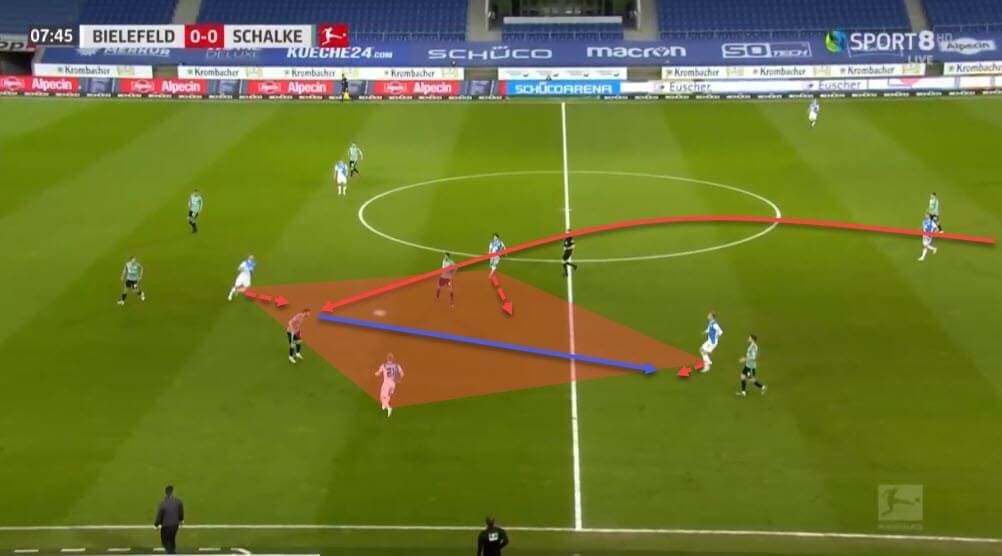
We see a clear 4v3 situation, at least one outlet in prime position to advance and support arriving just behind them. In theory and according to our checklist, this is an almost ideal setup for a successful counter-press, which, we can argue, has been pre-determined by the counter-pressing team who opted to yield possession in the first place.
Deliberate ‘passive’ and ‘active’ yielding of possession
If you’ve never heard of ‘passive’ and ‘active’ yielding of possession, I’ll give you a pass because that’s the term I’ve coined specifically for this section of our tactical analysis. In football, there are numerous ways to yield possession but when it comes to deliberately doing so, one can achieve it either passively or actively.
Let’s start with the more obvious one – the latter. Actively losing possession on purpose would be passing it straight into an opposing player while not exactly aiming at a clear teammate option in that specific area. It may be difficult to comprehend at first but the end goal is once again the very same – to counter-press and regain possession in a previously inaccessible zone.
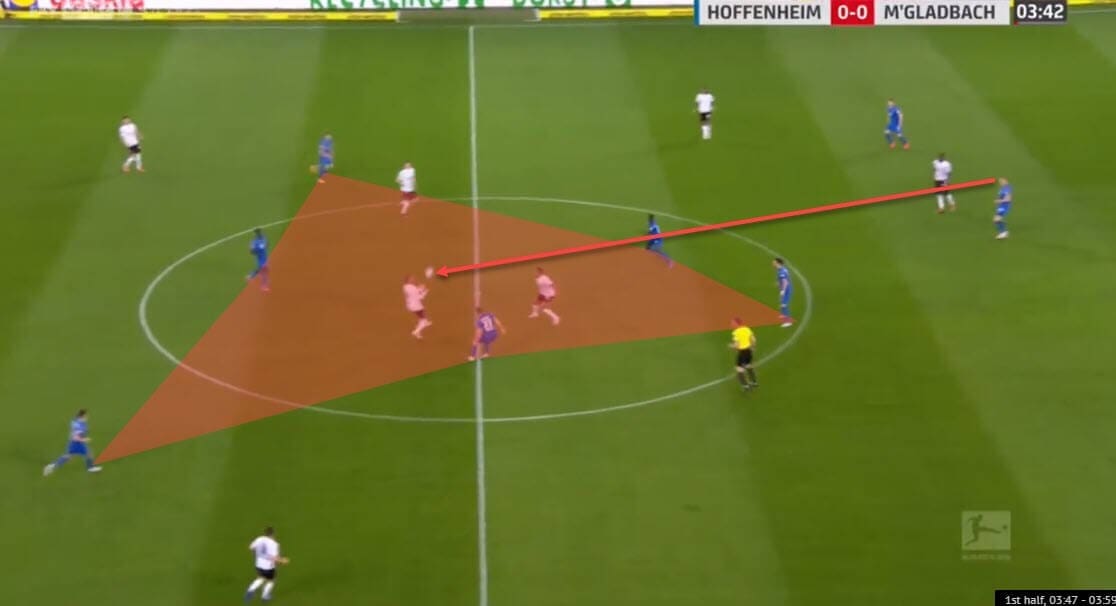
In this instance, Hoffenheim seemingly guided the ball to an area where the opposition have their teammate outnumbered. Immediately, you may notice that there were better and closer options available instead but you have to take into consideration that they would have to receive a ball that’s likely to be difficult to control with backs to goal and at least two markers immediately pressing them from behind.
Such a pass invites pressing and while Hoffenheim have the quality to escape it by other means, this is an alternate approach. They guide the ball towards opposition players because, in a matter of moments, they will have a 6v3 collapse ready to be deployed.
One other way of guiding the ball to an area where counter-pressing is more likely to be successful is to manipulate the movement of the opposition with a seemingly misplaced pass. Strasbourg do a very similar thing in the following example.
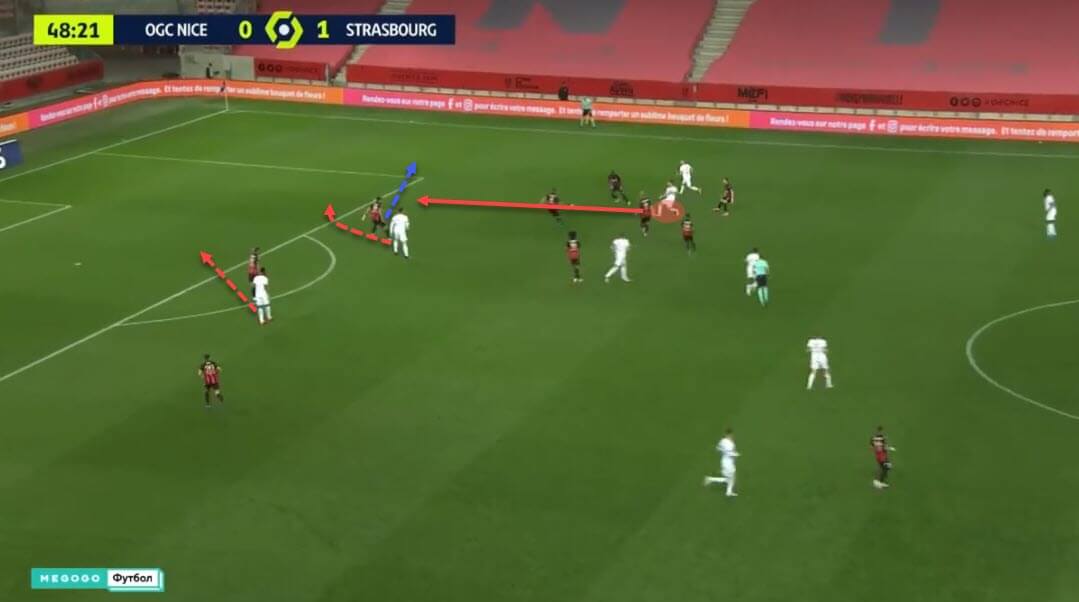
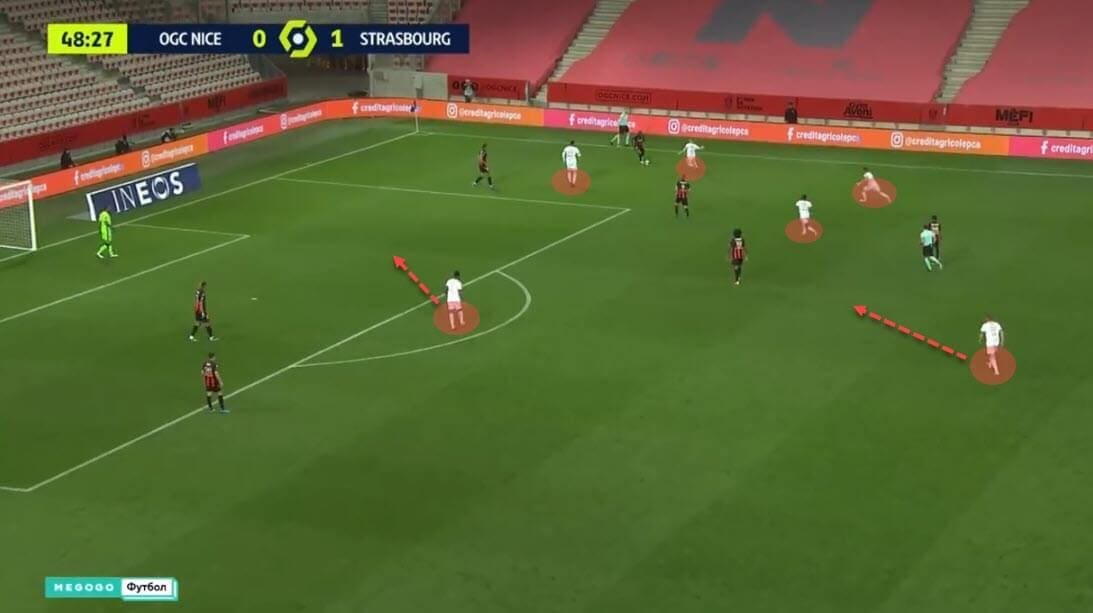
The initial pass is intercepted by the defender but the way Strasbourg’s pressing is coordinated makes for effective closing of available passing channels. The forward curls his run to shut off the backpass option, all the while forcing the ball-carrier wide.
Soon, the collapse is ready and Strasbourg tick all the boxes we predetermined for a successful counter-pressing structure – they achieve an overload (4v3), have a clear outlet who can receive in dangerous areas and have also secured some cover should the pressing unit fail.
So this was actively losing the ball on purpose where some teams will deliberately pass into opposition players or areas just to guide the ball towards a zone where counter-pressing will be more effective and easier. But what about doing it passively?
Well, yielding possession passively is when you do it off the ball. In this instance, we’re talking about pressing traps. Of course, pressing traps are typically associated with open play sequences rather than quick counter-pressing but also include a team opting not to engage the ball and/or yielding territory to set up a good pressing structure.
Let’s observe a couple of examples.
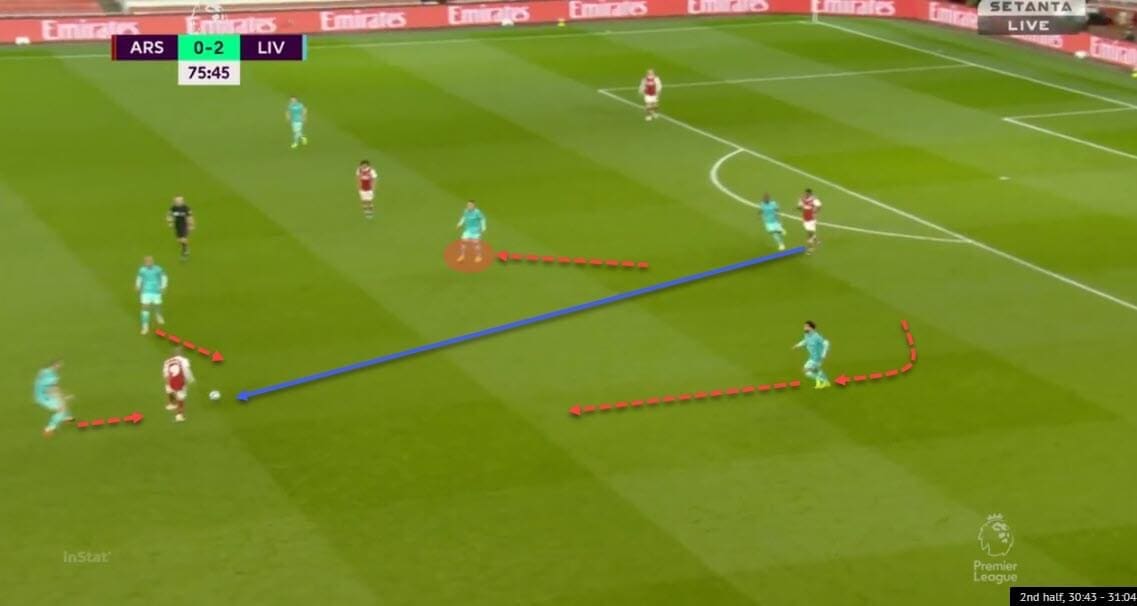
In this example, Liverpool deliberately yield territory by a) not pressing intensely from the front and b) opening up a passing channel to lure Arsenal in. But this is not a mistake by the Merseyside Reds as this triggers a quick pressing sequence that regains possession and sets up a quick transition into the danger area.
Pressing traps can occur anywhere but usually, they are all about guiding the ball towards an area of superiority, whether that be a tight central corridor or a small space next to the byline. In other words, it shares some principles with our previous concepts.
Our next example shows Brest, typically a non-possession-dominant outfit, execute a similar thing. By letting a wide channel open for Marseille, they invite their opposition to make the pass.
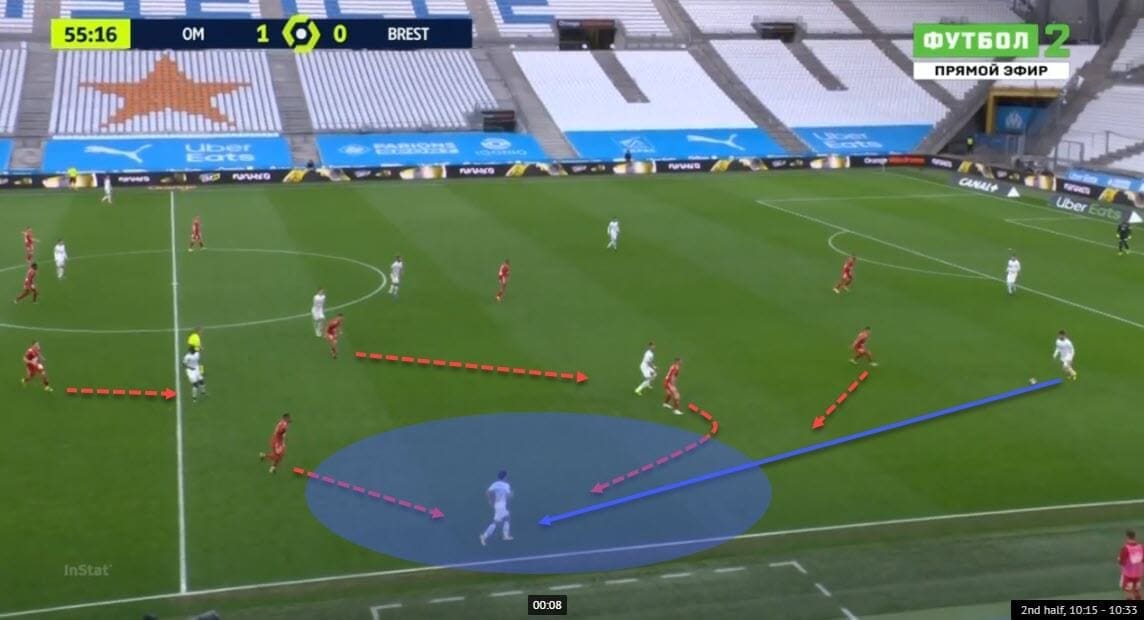
Notice the timing of the press – only once the pass has been played do the Brest players start the collapse. Run too early and you reveal your intentions. Run too late and you give the opposition a bigger window to escape the press.
Pressing traps are not counter-pressing nor yielding of possession in a literal sense as you can’t yield something you don’t have. But it is a way of deliberately giving up an advantage – which can be territory, a pass or a passing channel – to instigate a recovery which can lead to promising opportunities.
Final remarks
Finding solid proof of teams deliberately losing possession was always going to be difficult. However, this tactical analysis has hopefully shed some light on how the cost of the loss of possession can not only be minimised but also turned into a clear advantage.
Rather than accepting the ball will be lost, teams who are effective at deploying such tactics make calculated risks and prepare to turn those situations around quickly. Sometimes, it won’t come with a huge reward like a goal or a clear-cut chance but simply to advance and gain territory by temporarily yielding it.
One step backwards and two steps forward, every time.






Comments